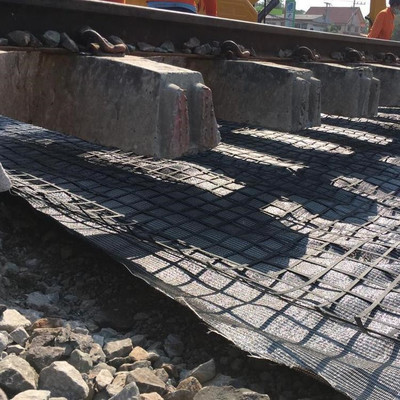
Construction Steps
2.1 Subgrade Preparation
✔ Compaction Degree ≥95% Standard Proctor Density (AASHTO T180)
✔ Flatness ≤3cm as Detected by a 3m Straightedge
✔ Remove Sharp Objects (Stones with a Particle Size >5cm Need to Be Screened Out)
2.2 Geogrid Installation
Layout and Positioning:
Lay along the Longitudinal Direction of the Line (Perpendicular to the Direction of the Rails)
Lap Width: Longitudinal ≥30cm, Transverse ≥50cm
Tensioning and Fixing:
Anchor with U-shaped Nails (Spacing 1m×1m)
Add Anchor Trenches at the Slope Surface (Depth 50cm×Width 30cm)
Joint Treatment:
Plastic Geogrid: Hot Melt Welding (Temperature 380±20℃)
Steel-Plastic Geogrid: Special Connecting Fasteners
2.3 Fill Placement
Layer Thickness: ≤30cm/Layer (Rolled with a Vibratory Roller)
Particle Size Control: Ballast ≤5cm, Subgrade Soil ≤10cm
Compaction Degree: The Surface Layer of the Roadbed Bed ≥97%, the Bottom Layer ≥95%
Quality Control
Items Inspection Methods Allowable Deviations
Laying Position Measured by Total Station ±5cm
Lap Width Detected by Tape Measure +10cm/-0cm
Anchor Strength Pull-Out Test ≥1.5kN/Anchor Point
Fill Compaction Degree Nuclear Density Gauge ≥2% of the Design Value
Railway-Specific Applications
4.1 Soft Ground Improvement
Composite Foundation: Geogrid + Stone Columns (Increase the CBR Value by 3-5 Times)
Settlement Control: Reduce Differential Settlement ≤1cm/10m
4.2 Ballast Reinforcement
Geogrid Position: Lay at the Bottom of the Ballast Layer
Effect: Reduce the Maintenance Frequency by 50%
4.3 Transition Zones
Lap Length: ≥10m (at the Connection of the Abutment/Culvert)
Slope: Gradual Transition with a Ratio of 1:2
Performance Advantages
Indicators Subgrade with Geogrid Traditional Subgrade
Post-Construction Settlement ≤2cm/Year 5-8cm/Year
Dynamic Stiffness Increase by 40% Baseline Value
Maintenance Cycle 8-10 Years 3-5 Years
Key Precautions:
⚠ Direct Rolling of the Geogrid by Machinery is Prohibited (A 20cm Protective Layer Needs to Be Laid First)
⚠ Stop Welding Operations in Rainy and Snowy Weather
⚠ Long-Life Design: Consider 2 Million Load Cycles
Standards Compliance:
✔ TB 10118-2019 (Code for Design of Railway Subgrades)
✔ EN 15381 (Geosynthetics for Railways)
✔ AREMA Chapter 1 (American Railway Engineering Code)
Keywords: Railway Geogrid, Subgrade Reinforcement, Ballast Layer Stabilization, Transition Zone Treatment
Technical Services:
→ Finite Element Modeling and Analysis
→ Dynamic Load Testing
→ Full Life Cycle Cost Assessment
